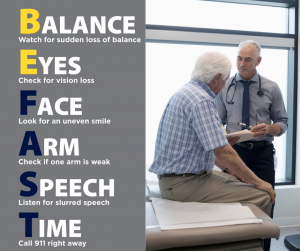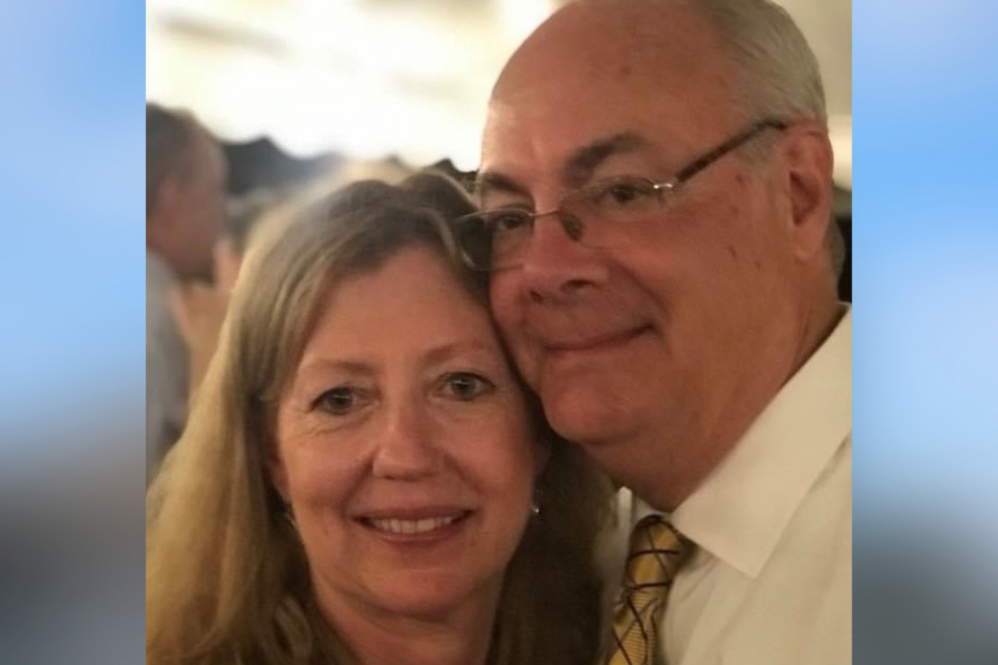It was a normal Monday morning at the gym for Christine Skelly when she began to feel dizzy and started sweating more than normal. She thought it might be the supplement she took before her workout as it had bothered her before. Realizing that she wasn’t well enough to continue with her exercise routine, she went home. She spent the rest of the week on the couch believing she had the flu. What she didn’t realize was she was having a life-threatening emergency.
Skelly’s husband brought her to the Emergency Department at UConn John Dempsey Hospital that Sunday where the emergency room team in collaboration with the neurosurgery team diagnosed her hemorrhagic stroke caused by a ruptured aneurysm.
There are two types of strokes, an ischemic stroke caused by a blockage in an artery or vein that prevents the blood flow to reaching an area of the brain. This is the most common type of stroke. A hemorrhagic stroke, the type Skelly was experiencing, was caused by a brain aneurysm that had leaked.
A hemorrhagic stroke is fatal in 1/3 of patients, who never even make it to the hospital. For those who make it to the hospital 1/3 will have deficits and never be the same again, the other 1/3 are fortunate to be okay.
“Christine was fortunate in that even though her aneurysm bled and she sought out care in a delayed fashion, she did not suffer a re-bleed. That would potentially have been fatal. Most of the re-bleeds happen within 24 to 48 hours, she was fortunate that she made it to our hospital,” says Dr. Ketan Bulsara, chief of Neurosurgery at UConn Health.
A diagnostic angiogram was performed by Dr. Abner Gershon, assistant professor of Radiology at UConn Health to better understand the aneurysm, the risks associated with treating it and the options to treat. Skelly’s aneurysm was in a very rare location with an unusual shape. The multidisciplinary team at UConn Health has great expertise in the microsurgical management of aneurysms and endovascular management. After considering all treatment options, Bulsara proceeded with endovascular treatment of her aneurysm.
A very small catheter about the size of two or three strands of hair was threaded through an artery in her leg. Coils closed off the aneurysm and were used to preserve the main blood vessels because otherwise the patient could potentially have a devastating stroke.

Skelly does not recall the trip to the emergency room or the two procedures she had. She awoke in the ICU and hadn’t known what happened and wondered why her friends and family were there.
While it is unclear what causes aneurysms, what is uniform is that there is a weakness in the blood vessel wall. Brain aneurysms can cause hemorrhagic stroke, and these are life threatening emergencies. If you are diagnosed with an aneurysm, it’s very important that you’re assessed by a team with expertise in both microsurgery and endovascular treatments to determine what the best treatment option would be if treatment is warranted.
“Most patients will present with a terrible headache often described as the worst headache of their life. Initially there is a small leak, called the sentinel bleed. It’s the precursor of a devastating potentially life threating bleed if nothing is done about the aneurysm,” says Bulsara. “She had a small leak that the brain was able to tamponade off, but it was a very precarious situation because she was likely going to have another bleed and that could have taken her life. The takeaway message is if you experience the worst headache of your life, seek medical care immediately. Skelly was truly fortunate that her aneurysm did not re-bleed during her delayed presentation.”
Skelly remained in the hospital for over two weeks and had physical therapy at home as well as a home nurse. She has started exercising again and is building herself up to where she was prior to the stroke. It’s a slow process and she tires more easily, but that is to be expected as the body heals. The place in the brain where this stroke took place affected her balance and she is having her hearing checked as she noticed she isn’t hearing as well, however she was lucky to have minimal deficits, if any.
“She is recovering extremely well, and I anticipate she should not have any permanent deficits,” says Bulsara.
Skelly will have annual surveillance imaging, but she should be cured of her aneurysm. In the meantime, Skelly is working to be well enough to complete her goal of riding 5,000 miles on her bike this season.
“I am so appreciative for the outstanding medical care by the doctors, nurses, PCAs and therapists at UConn Health,” says Skelly. “My family and friends have been an incredible support to me and I am so grateful to each and every one of them.”
At UConn Health, through our world class Brain and Spine Institute, a multi-disciplinary team of experts provides fast, efficient care for patients experiencing symptoms of stroke and personalized, ongoing care for patients who have already experienced a stroke or have other risk factors. Every minute counts when you suffer a stroke, if you believe you are having stroke symptoms, call 911 and get to the Emergency Departmen.t
May is Stroke Awareness Month: Know the Signs and BEFAST




